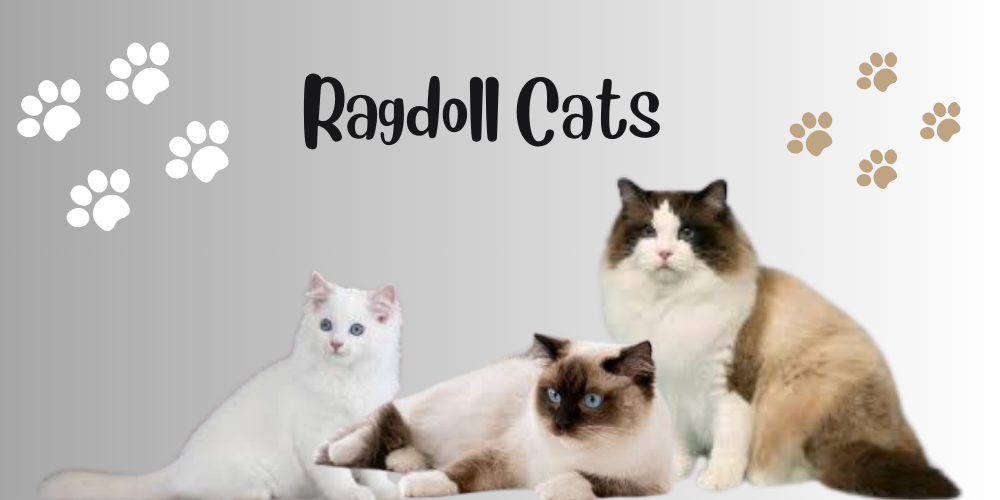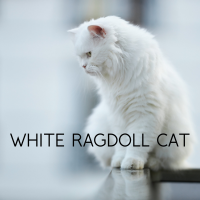When it comes to majestic and captivating feline breeds, the Ragdoll White Cats stands out for its striking beauty and gentle demeanor. Among the various Ragdoll colors and patterns, the white Ragdoll cat commands particular attention for its elegance and rarity. In this comprehensive guide, we will explore everything you need to know about Ragdoll white cats, including their characteristics, care requirements, and comparisons with other breeds. Whether you’re a potential owner, a current enthusiast, or simply a cat lover, this article will provide valuable insights into these enchanting cats.
What is a Ragdoll White Cats?
The Ragdoll White Cats breed is renowned for its large size, striking blue eyes, and affectionate nature. A white Ragdoll cat is distinguished by its pristine, pure white coat, which can sometimes include subtle variations in shades like off-white or cream. These cats are known for their soft, semi-long fur that feels like a plush toy, making them incredibly appealing.

Introduction to Ragdoll White Cats
- Ragdoll Cat White Grey Tips: Some white Ragdolls may exhibit faint grey or cream tips on their fur, adding a touch of uniqueness to their appearance. This subtle coloration does not detract from their overall white look but provides a slight contrast that enhances their beauty.
- Ragdoll Cat White Kitten: White Ragdoll kittens are adorable and often sought after for their pure, unblemished coats. They typically have a soft, fluffy appearance that grows more refined as they mature.
- Ragdoll Cat White Green Eyes: While blue is the traditional eye color for Ragdolls, some white Ragdoll cats may have striking green eyes. This eye color is less common but adds a distinctive charm to the cat’s overall look.
- Ragdoll Cat on White Background: Photographing a Ragdoll cat against a white background can highlight the purity of their coat and make their features stand out. This contrast often showcases their beauty more effectively.
- Ragdoll Cat Face Turning White: As Ragdoll kittens mature, their coats may change color. This phenomenon can lead to a white Ragdoll cat’s face becoming whiter over time, which is part of the breed’s natural development.
- Orange White Ragdoll Cat Maine Coon: Comparing the white Ragdoll to breeds like the Maine Coon, which can also have orange and white colorations, highlights the distinctive features of the Ragdoll’s coat and temperament.
- Names for White Ragdoll Cats: Choosing a name for your Ragdoll White Cats can be a fun and creative process. Popular names often reflect their striking appearance, such as “Snowy,” “Ivory,” or “Pearl.”
- Fluffy Black and White Ragdoll Cat: While our focus is on white Ragdolls, it’s interesting to note the contrasting appearance of black and white Ragdolls. They offer a different aesthetic but share the same charming personality traits.
- Blue Eyed White Ragdoll Cat: Blue eyes are a hallmark of the Ragdoll breed. A white Ragdoll with blue eyes is especially captivating, as the eye color contrasts beautifully with their coat.
- Are White Ragdoll Cats Deaf?: A common concern for white cats is whether they are more prone to deafness. In general, while white cats may have a higher incidence of congenital deafness compared to other colors, Ragdolls are not inherently deaf.
- American White Ragdoll Cat: This term refers to white Ragdoll cats bred in America. They adhere to specific breed standards and are known for their distinct characteristics.
- White Ragdoll Cat Temperament: White Ragdolls are known for their affectionate and gentle nature. They are typically friendly, sociable, and enjoy spending time with their human companions.
- White Persian Ragdoll Cat: While the Persian breed is distinct from the Ragdoll, comparisons are often made between the two, especially in terms of their coat types and appearance. The Ragdoll’s coat, while similar in length, tends to be less dense than that of the Persian.
The Rarity and Value of White Ragdoll Cats
- Ragdoll Kittens Seattle: If you’re looking to purchase a Ragdoll kitten in Seattle, you may find a range of options, including white Ragdoll kittens. Local breeders and adoption centers will have information on availability.
- White Ragdoll Cat for Sale: Finding a Ragdoll White Cats for sale requires checking reputable breeders and adoption centers. Ensure the breeder follows ethical practices and provides a healthy environment for their cats.
- How Rare is a White Cat?: White cats, including white Ragdolls, are relatively rare compared to other colors. This rarity can make them more sought after and sometimes more expensive.
- Solid White Kitten: Solid white kittens are less common and can be particularly desirable. They often have a striking, uniform coat that makes them stand out.
- White Cat Breeders: Ragdoll White Cats can be found through breeders specializing in white or predominantly white cats. Research breeders thoroughly to ensure they meet high standards of care and ethics.

Characteristics of Ragdoll White Cats
- Purebred Ragdolls: White Ragdolls are often purebred, meaning they adhere to the breed standards established by cat fancier organizations.
- Haired Cats: The Ragdoll’s long, semi-long coat is a defining feature. Understanding the grooming needs of haired cats can help in caring for a Ragdoll’s coat.
- Ragdoll Breed: The Ragdoll breed is known for its unique appearance and gentle temperament. White Ragdolls are simply a variation within this breed.
- Ragdolls Don: “Ragdolls don” refers to the idea of the Ragdoll’s distinctive traits and characteristics, which include their beautiful coat and affectionate nature.
- Blue Eyed: Blue eyes are a defining characteristic of the Ragdoll breed and are particularly striking in Ragdoll White Cats.
- Ann Baker: Ann Baker is credited with developing the Ragdoll breed. Understanding the breed’s history can provide insights into its characteristics, including those of white Ragdolls.
- Eye Color: Eye color in white Ragdolls can vary, but blue eyes are most common. Other colors, like green, are less typical but equally beautiful.
- Ragdoll Cat: The Ragdoll cat is a popular breed known for its striking appearance and affectionate personality. White Ragdolls are simply one of the many variations within this breed.
- White Cat: White cats in general, including white Ragdolls, are admired for their pure and elegant appearance.
- Kittens are Born: Understanding the birth process of Ragdoll kittens, including those that are white, can provide insight into their early development and care needs.
- White Ragdoll: A white Ragdoll refers specifically to Ragdolls with a predominantly white coat. This coloration is less common but highly sought after.
- Cat Breeds: The Ragdoll is one of many cat breeds, each with its own unique characteristics. The white Ragdoll stands out within this diverse group.
- Pure White: Pure white Ragdolls are particularly striking due to their uniform coat color. This purity of color adds to their allure.
- Long Haired: The Ragdoll’s long, soft fur is a key feature of the breed. Understanding how to care for long-haired cats is essential for maintaining their coat.
Ragdoll White Cats Care and Maintenance
Grooming: Ragdoll White Cats require regular grooming to keep their coats clean and free of mats. Their long fur can attract dirt and debris, so brushing several times a week is recommended. Additionally, regular baths can help maintain the whiteness of their fur.
Diet: A balanced diet is crucial for maintaining a Ragdoll’s overall health and coat condition. High-quality cat food that meets their nutritional needs will support their coat and general well-being.
Health Concerns: Regular veterinary check-ups are essential for white Ragdoll cats to monitor their health. While they are generally healthy, some may be prone to conditions like deafness, so it’s important to be aware of potential issues.
Ragdoll White Cats Health
Health care for a white Ragdoll cat involves a combination of regular veterinary check-ups, a balanced diet, grooming, and monitoring for common health issues. White Ragdolls, like all Ragdoll cats, may be prone to certain conditions, such as hypertrophic cardiomyopathy (a heart disease) or dental issues, so regular vet visits are essential for early detection and management. A high-quality diet tailored to their age, weight, and activity level helps maintain a healthy coat and overall well-being. Grooming is important due to their semi-long fur, which requires regular brushing to prevent matting and reduce shedding. Additionally, keeping an eye on their eyes, ears, and skin for any signs of irritation or infection is key to maintaining their health and comfort.
Behavior: White Ragdolls, like all Ragdolls, are known for their calm and affectionate nature. They enjoy being around people and are often described as “lap cats.” They may also be quite playful and enjoy interactive toys.
Ragdoll White Cats Training
Training: Training a white Ragdoll is similar to training other Ragdolls. Positive reinforcement techniques work best, and consistency is key to successful training.
Taining a white Ragdoll cat focuses on using positive reinforcement to encourage desired behaviors while building a strong bond with your pet. White Ragdolls, like all Ragdolls, are intelligent, social, and eager to please, making them relatively easy to train. Training should start with basic commands, such as “sit” or “come,” using treats, praise, and playtime as rewards. Litter training, teaching them to use a scratching post instead of furniture, and gentle leash training for indoor-outdoor excursions are also essential. Consistency, patience, and short, engaging sessions are key to successful training, helping your white Ragdoll learn and adapt while feeling loved and secure.
Use Positive Reinforcement:
Reward good behavior with treats, praise, or playtime to encourage repetition.
Start with Basic Commands:
Teach simple commands like “sit” or “come” using short, consistent training sessions.
Litter Box Training:
Ensure the litter box is easily accessible and clean; reward your cat for using it correctly.
Teach Scratching Post Use:
Redirect your cat to a scratching post and reward them when they use it instead of furniture.
Leash Training:
Introduce a harness and leash gradually for safe, supervised outdoor exploration.
Be Consistent and Patient:
Keep training sessions short and regular, and use a calm, gentle approach.
Socialization:
Expose your cat to different people, pets, and environments to build confidence and reduce anxiety.

Conclusion
Ragdoll White cats are a captivating and rare variation of the Ragdoll breed. Their pure, elegant appearance combined with their affectionate nature makes them a prized companion for many cat lovers. Whether you are considering adopting one or simply appreciate their beauty, understanding their characteristics and care needs will ensure that you can provide the best environment for these enchanting felines.


